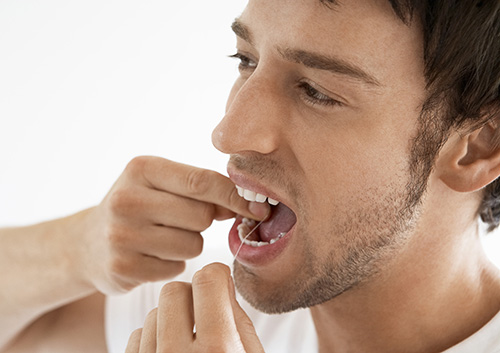What’s the advantage of Invisalign®?
November 17th, 2021

Drs. Angela Paros, Amer Atassi, Eric Young, Alexander Katsnelson and our team know it is natural for you to feel some concern when you need to wear any type of dental device to correct a problem with your teeth. Both braces and Invisalign can produce good results in giving you the smile you’ve always wanted. Both methods can straighten your teeth and alleviate such issues as crowding, spacing, cross bite, overbite, and underbite. Both methods of treatment have a similar cost.
You can take a cross-country road trip in a ten-year-old economy car or you can make the trip in a brand-new luxury sedan. Both will get you to your destination, but you will be far more comfortable traveling in the luxury sedan. Similarly, your journey to a great smile is much more comfortable and convenient with Invisalign as opposed to braces.
Comfort
Some of the discomfort you may experience with braces is greatly reduced with Invisalign. Because Invisalign is custom-fit to your mouth and made of plastic, you will feel less pain, irritation, and soreness. Unlike braces, there are no food restrictions; you can eat anything that is on your diet.
Brushing and flossing
Of course you will want to brush and floss your teeth to prevent plaque buildup, tooth discoloration, and dental decay. If you wear braces, these simple tasks can become quite a challenge. Invisalign aligners are very easy to remove and replace, so you can brush or floss like normal without having to work your way around any metallic framework covering your teeth.
Appearance
You do not have to be embarrassed to show your teeth when you are using the Invisalign system. Since the aligners are practically invisible, no one will even notice you are wearing them! Whether you are a teenager or an older adult, you can live your life normally.
If you want to learn more about Invisalign, or are wondering what your treatment options are at High Point Dental Group, feel free to give us a call at our convenient Romeoville, IL office!
A Spot of Trouble?
November 10th, 2021

Your smile is in the spotlight every day, helping you greet the world with confidence! But when you’re self-conscious about discolored spots on your teeth, it’s time to get some professional advice to deal with these troublesome tints.
Discolored patches, both dark and light, can develop for a number of different reasons. Some markings are cosmetic only, and some spots require treatment. Some can be removed with a professional cleaning, and some might require more serious restoration. Let’s have a look at some of the common causes of enamel discoloration.
- Cavities
Decayed enamel can appear as a brown spot on the tooth. A dark edge around a filling might mean decay underneath.
Regular checkups at our Romeoville, IL office will help catch small cavities before they become big ones. If you need a filling, the filling color can be matched to your tooth color for an undetectable restoration.
- Demineralization
Bacteria in plaque produce acids, which attack our teeth. These acids erode minerals such as calcium and phosphorus from enamel, leaving a weak spot that is vulnerable to decay. This process is called “demineralization,” and often leaves a whiter spot on a tooth where minerals have leached away. Common reasons for demineralization are neglecting dental hygiene, failure to clean around braces, and a diet filled with sugary and acidic foods.
Fluoride and enamel-strengthening toothpastes, a healthy saliva flow, and a balanced diet help our teeth “remineralize,” bathing teeth in minerals that can help replace those that have been lost. But if you have lingering white spots due to demineralization, Drs. Angela Paros, Amer Atassi, Eric Young, Alexander Katsnelson can provide some options, including whitening, microabrasion, and veneers.
- Fluorosis
Fluorosis is a cosmetic condition caused by exposure to too much fluoride while the permanent teeth are still forming (generally, during the years before a child’s eighth birthday). Small white spots and patches are a common result of mild fluorosis. In more serious cases, teeth can be pitted and stained with brown, gray, or black spots.
Preventing fluorosis begins in early childhood. Talk to Drs. Angela Paros, Amer Atassi, Eric Young, Alexander Katsnelson about fluoride levels in local tap water if you have any concerns. Use only the recommended amount of toothpaste (the size of a grain of rice for children three and under; the size of a pea for children three to six), and show your child how to spit out toothpaste and rinse after brushing. Keep fluoride toothpastes and other fluoride products out of the reach of young children. Don’t give children fluoride supplements or fluoride rinses without discussing it with Drs. Angela Paros, Amer Atassi, Eric Young, Alexander Katsnelson.
If your own teeth have been affected by fluorosis, talk to us. Again, this is a cosmetic condition affecting otherwise healthy teeth. Whitening treatments can be helpful in mild cases, microabrasion has been effective for mild to moderate cases, and, for severe cases, cosmetic restorations such as bonding and veneers are an option.
- Tartar
Are you seeing an accumulation of dark brown spots and stains on your teeth, especially between the teeth and at the gum line? This might mean that you have tartar buildup. When you brush plaque away every day, your enamel stays smooth and clear. But when plaque builds up over time, it hardens and becomes tartar.
How hard is tartar? So hard that it can only be removed with a professional cleaning. Eliminate this source of spots and staining with twice daily brushing and daily flossing, and make sure regular professional cleanings are on your calendar.
- Other Causes
Medications taken while teeth were developing (notably, antibiotics in the tetracycline family) can cause discoloration. Medical conditions such as celiac disease and enamel hypoplasia can affect both tooth color and enamel formation.
Cosmetic treatment and restorations can help with discoloration caused by medications, and restorations such as bonding, veneers, and crowns can restore tooth appearance and function when medical conditions cause imperfections in enamel color and structure.
If you’re unhappy with the overall whiteness of your smile, a professional whitening might be just what you’re looking for. If specific patches, streaks, and spots of a different color are dimming your bright smile, it’s time for an exam. Drs. Angela Paros, Amer Atassi, Eric Young, Alexander Katsnelson will be able to tell you the reason for any discolored enamel as well as present you with all your treatment options. Put the spotlight back where it belongs—on your healthy, confidant smile!
Eat Well, Heal Better after Periodontal Surgery
October 27th, 2021

You’ve got periodontal surgery at our Romeoville, IL office coming up on your calendar and you’re prepared. The freezer is stocked with frozen yogurt, the fridge is filled with pudding and applesauce, the cupboard has boxes of gelatin dessert just waiting to be mixed and chilled.
Good for you! Eating a soft, smooth diet is the best way to treat delicate tissue after surgery. Now, let’s look at a few ways to make that diet not only soothing, but healing.
- Protein
Proteins are essential for all of our vital bodily functions. The protein in our diet is broken down into amino acids, which then combine with other amino acids to create the new protein building blocks our cells need to replace and repair damaged tissue. These proteins provide structure for cells in the skin, bone, and blood vessels as they recover. When you are healing, your body requires more protein than usual to help the process along.
Of course, right after periodontal surgery, you won’t be eating your regular protein sources of meats, seafood, beans, and nuts. But dairy foods such as yogurt and milk products are also rich in protein—and delicious in milkshakes and smoothies. You can also add a protein supplement if you will be eating soft foods for a while. Just remember, no straws!
- Vitamin A
Vitamin A helps stimulate cell reproduction and the immune system, both important factors for quicker, safer healing. It also helps our bodies form and maintain bone tissue, mucous membranes, and soft tissue, all of which are involved in bone and gum recovery after surgery.
If you are wondering where to get more vitamin A, think green and orange. Spinach, kale, leaf lettuce and other leafy greens, mild peppers, carrots, cantaloupe, mango—all these foods keep you supplied with vitamin A. How to get those solid foods into your soft diet? Think smoothies. Adding some fresh ingredients to your blender will give you this important vitamin in an easy-to-drink form.
- Vitamin C
Vitamin C is vital for wound healing because it is essential in forming the protein collagen. Collagen provides both structure and support to our tissues, especially important as tissues heal.
We usually associate vitamin C with citrus fruits such as oranges, lemons, and limes. But if you’re avoiding acidic foods because they might irritate delicate tissue, you can also find plenty of vitamin C in green vegetables such as broccoli, cabbage, and kale, or in fruits like strawberries, mangos, and papayas. Here’s where that blender comes in handy again!
- Zinc
Zinc has been found to improve healing by promoting membrane repair, blood clotting, and skin cell recovery, and by helping to boost immunity. Too little zinc in the diet has been associated with slower wound healing, especially in the skin—and because our bodies don’t store zinc, it should be part of everyone’s regular diet.
Foods high in zinc include red meat and seafood, but since steak is off the menu for a while, where can you find another good source of zinc? Dairy products, again! Let your milkshake do double duty.
Of course, there is no one magic diet that brings instant recovery. But if you follow Drs. Angela Paros, Amer Atassi, Eric Young, Alexander Katsnelson and our team’s advice, eat foods designed to soothe rather than irritate your recuperating tissue, and take advantage of the nutrients that encourage healing, you will be doing all you can to make your recovery speedy and healthy. Good for you!
Help! My gums hurt when I floss!
October 20th, 2021

By no stretch is it rare for your gums to hurt during and after flossing. Even some bleeding is to be expected. This is especially true if you have not flossed in a long time. However, if your gums do indeed hurt when you floss, and unbearably so, there are some things you can do.
Be Gentle
Perhaps the most obvious way to combat gum soreness and bleeding is to be gentle. One of the most common occurrences of these gum problems is over-aggressive flossing. In other words, if you are too rough on your gums while flossing, either because you are out of practice or because you are in a hurry, soreness and hurting is to be expected. Instead, try taking your time and be gentle. Also, if you are just starting out, be patient and consistent, your gums will become more conditioned over time.
Use an Alternative Method
If being consistent and gentle does not work, there are other alternative methods of flossing that you can try. You can also try a water floss machine, or what is sometimes called a water pick. The device essentially shoots water into the crevasses between your teeth, and in other areas of your mouth, in order to dislodge food and plaque. These oral instruments also come with different attachments that allow you to reach many of the hard to see and reach areas of your mouth. And lastly, you can always buy floss that is not as abrasive to your gums. There is floss that comes with soft and gentle coatings that will do less harm to your gums while they are adjusting to the good oral hygiene habit you are creating.
Flossing is one of the easiest parts of oral hygiene to overlook. When you first start out, it is common that you may want to stop because of the pain it can initially cause. However, if you try one, or all, of the above mentioned methods, you will give yourself the best chance of being success with your flossing, and it won't hurt as much.
For more flossing tips, schedule an appointment at our Romeoville, IL office and askDrs. Angela Paros, Amer Atassi, Eric Young, Alexander Katsnelson or a member of our team!






